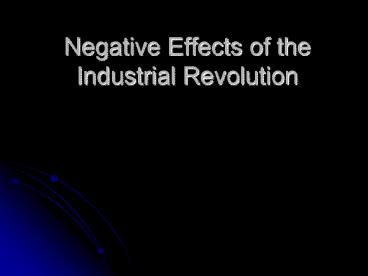Negative Effects of the Industrial Revolution - PowerPoint PPT Presentation
1 / 35
Title:
Negative Effects of the Industrial Revolution
Description:
Negative Effects of the Industrial Revolution Legislation & Reform Child labor was only limited, not abolished Kids in textile mills only were limited to 12 hour ... – PowerPoint PPT presentation
Number of Views:102
Avg rating:3.0/5.0
Title: Negative Effects of the Industrial Revolution
1
Negative Effects of the Industrial Revolution
2
The Haves
- The entrepreneurs (Individuals who start a new
business) who opened factories and shipping
companies became very rich during the early
industrial revolution.
3
The Have-Nots
- The people who worked in the factories for the
entrepreneurs (the working class), were
soul-crushingly poor
4
Urbanization
- Urbanization The movement of people to the
cities - The Industrial revolution brought rapid
urbanization.
5
Causes of Urbanization
- Population explosion
- High demand for workers
6
Dont Forget!
- The enclosure movement pushed people off the
farms and into the cities
7
(No Transcript)
8
(No Transcript)
9
City Life
- Cities grew around factories
- These cities grew rapidly, without planning
- Working people lived in tenements in hellish
slums - The lack of planning meant that there was no
sewage, running water, or sanitation system
10
(No Transcript)
11
(No Transcript)
12
No sanitation meant the streets were filled with
trash
13
The crowded, filthy slums were a breeding ground
for diseases such as cholera
14
Working Life in Factories
- Factory work was difficult and dangerous
- Typical shifts lasted 12 to 16 hours
- If you complained, you were fired.
- If you got sick, you were fired.
- If you got hurt and could no longer work, you
were fired.
15
Women at Work
- Factory owners hired women because they could pay
them less - Women with families worked 12 hours a day and
were still expected to cook, clean, etc. when
they finally got home.
16
Children at Work
- Families needed the income working children could
provide. - Children could be hired at very low wages
- Children worked in the same dangerous factories,
for the same long hours
17
(No Transcript)
18
Workers respond to the awful conditions of their
lives
- 1) Workers protested their conditions
- These protests were put down violently by the
British government
19
Worker Responsecontinued
- 2) Luddites skilled workers rejected the new
machines that cost them their jobs by smashing
them
20
Worker responsecontinued
- 3) Methodism a new religious movement founded by
John Wesley. Working people tried to focus on a
better life to come rather than their lives on
earth
21
New Ways of Thinking
- The industrial revolution changed the way people
thought about everything from economics to the
way governments should work.
22
Economics
- David Ricardo
- The Iron Law of Wages
- Workers should be paid only enough to survive
- If they make more money, they will have more
children, become poor die off from starvation
23
Iron Law of Wagescontinued
- Workers should be satisfied with their wages,
because they are at a natural level - Ricardos ideas lead many to the conclusion that
people are poor because of some personal flaw in
their character
24
The Rise of Socialism
- Critics of the industrial revolution wanted a
more equal distribution of wealth - Many were labeled Utopians because people
thought their ideas would be impossible to put
into practice.
25
Rise of Socialism
- Robert Owen Set up ideal working community
called New Harmony. Workers worked less,
children were taken care of while parents worked
productivity and profits increased.
26
Communism Capitalism
- Karl Marx and Frederic Engels witnessed the
horrors of industrialization - Together they wrote The Communist Manifesto.
- The following chart outlines the differences
between capitalism communism
27
Capitalism Communism
Founder Adam Smith Karl Marx
Books The Wealth of Nations The Communist Manifesto Das Kapital
28
Capitalism Communism
View of Government Government should not interfere with economy laissez-faire Everything is owned by the government Government closely regulates the economy (sets prices, tells factories what to make, etc.)
29
View of people People become wealthy because they offer a good or service that people want to buy People should cooperate to achieve success, no competition Everyone should have an equal share of the wealth/property
30
How to improve social conditions? If people work hard enough, they can lift themselves out of poverty Government ownership of the economy will end hunger, poverty, and slave-like working conditions From each according to their abilities to each according to their needs
31
Individual Freedoms People are free to choose their own careers Freedom of religion Freedom is more important than security Government determines job placement Religion is the opiate of the masses and should be done away with Sacrifice freedom for security
32
On the future Capitalism is the only efficient economic system Its not perfect, but its the best we can do Capitalism will destroy itself Workers will eventually rise up in a violent revolution and take power The future of the world is communism
33
Legislation Reform
- Early attempts to regulate factories were weak
and ineffective - Unions were outlawed because they would interfere
with the natural orderremember Ricardo
34
Legislation Reform
- Child labor was only limited, not abolished
- Kids in textile mills only were limited to 12
hour workdays. Those in mines, shipyards and
factories worked more than 12 hours a day
35
Legislation Reform
- Factory Acts of 1833, 1842 1847
- limited child labor
- Prohibited children under 10 in the mines
- Set the maximum number of working hours for women
and children at 10.































